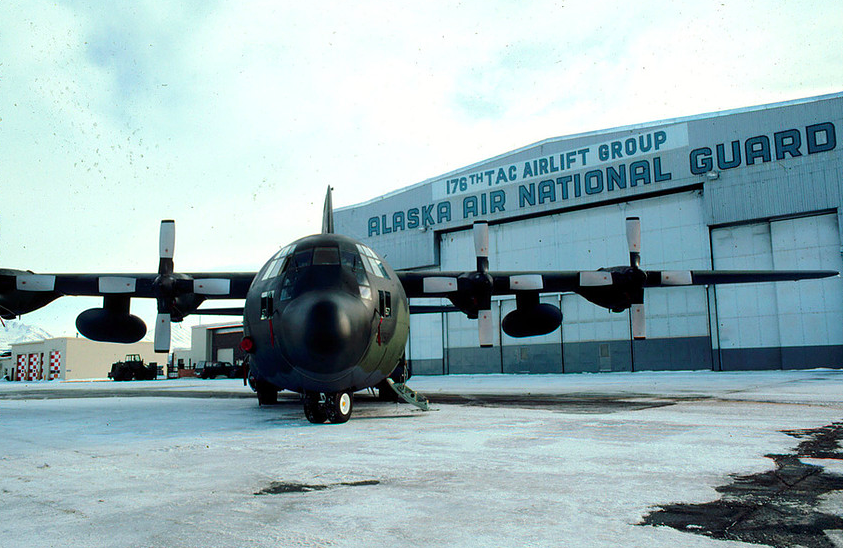CELEBRATION BARBECUE SATURDAY 2-4 PM
The legendary Air National Guard base on the far side of the Ted Stevens International Airport has been added to the National Historic Registry, a major step toward the creation of the Alaska Military Heritage Museum.
The hangar was added to the registry in March, said Ric Davidge, one of members of the organization that is preserving this part of Alaska’s military history.
Over 300 Kulis veterans are expected to attend the Saturday celebration of the Historic Registry designation, and a barbecue is planned. The address of the historic airbase is 5005 Raspberry Road.
[Click here for the Alaska Military Heritage Museum website]
Kulis Air National Guard Base dates back to the Cold War era of the 1950s. In fact, Kulis groundbreaking was 65 years ago in April.
During the Great Alaska Earthquake of 1962, the China River flood in 1967, and the Exxon Valdez oil spill in 1989, the air base served as a hub for disaster relief, rescue and defense support.
Kulis also deployed airmen in support of Operations Enduring Freedom and Iraqi Freedom.
The base was shut down in 2011 during a Base Realignment and Closure.
The Alaska Military Heritage Museum organization has been working hand-in-hand with the State of Alaska for years to protect the asset and develop a museum that preserves this piece of Alaska’s unique military history from Territorial days forward.
Bernie Kale, formerly with the Alaska Air National Guard, wrote a history of Kulis in 2011, as the base was closing:
On Sept. 15, 1952, the federal government recognized the Alaska Air National Guard as the 8144th Air Base Wing.
Eleven enlisted men, five officers and zero airplanes comprised the brand new wing whose headquarters was a small Fourth Avenue office in downtown Anchorage.
Once the wing received an aircraft, a single T-6G “Texan” trainer, the members trained out of then-Elmendorf Air Force Base. Soon, five more trainers arrived and the Alaska Air Guard was on its feet.
In keeping with the Air Guard’s mission to provide national air defense, the pilots began training in earnest for their planned transition to jet fighters.
As that training progressed, the unit was redesignated the 144th Fighter-Bomber Squadron in July 1953.
Nov. 16, 1954, was a dark day for the young organization.
First, a T-33 on a training flight over Point McKenzie checked in with ground controllers, and then simply vanished.
Neither the plane nor its occupants, Lt. Roger Pendleton and Capt. Lionel Tietze, were ever seen or heard from again.
Less than a half-hour later, a training flight of three F-80s led by 1st Lt. Albert Kulis passed in formation over the Goose Bay area, on the west side of Knik Arm.
His wing man watched as Kulis’s fighter went into a steep, diving turn and vanished into a cloud bank.
Two weeks later, wreckage belonging to Kulis’s jet was spotted in the mud at Goose Bay, but the fighter sank before recovery.
After an informal vote, the new base alongside Anchorage International Airport was to be named Kulis Air National Guard Base.
Over the years, Kulis Air National Guard Base has filled multiple roles for the nation and state.
The base was the coordination center for disaster relief following the 1964 Good Friday earthquake.
Within 20 minutes after the quake ended, the Anchorage Times reported that Guard members began streaming into Kulis without even being called.
“We had set up 100 beds where people could stay and opened up the mess hall and started serving people who didn’t have a place to go,” said retired Air Force Lt. Col. Harold Wolverton, former Kulis Air National Guard Base commander between 1963 and 1969.
During the earthquake, the Anchorage International Airport control tower collapsed, leaving no communication between aircraft and the airfield.
Wolverton said the Guard responded within minutes.
“We had set up a mobile control tower in our C-123 that was in the air right after the quake. We were the source of communication for flights in and out of Anchorage,” Wolverton said.
The Alaska National Guard provided airlift, supplies and shelter for the communities that had been affected by the devastation.
Over the next two weeks, the Air National Guard flew 131,000 pounds of cargo and 201 passengers in support of earthquake relief efforts.
The performance earned the 12-year-old organization the Air Force Outstanding Unit Award.
“Our responsive service to the state as well as the nation is our history. Our legacy will remain intact,” Wolverton said.
It is that kind of dedication and commitment that members from the 176th Wing have shown time and time again in the face of disaster, and as the doors close on Kulis, we Alaskans are reminded that the proud heritage of Kulis is not in the buildings, but in the spirit of every Guard member who wears the uniform.

Great idea for military museum.
TSAIA management should be ashamed of itself. To prevent a group of veterans and other supportive members of the community reasonable access to a facility that has been added to the National Register of Historic Places is a travesty. For those who gathered to celebrate the memory of the important events that happened there and those who served, it was a cold, windy, rainy afternoon in the parking lot of the elementary school on the other side of Raspberry Road.
You’re right Bob Gastrock, but the folks who stood in that rainy and blustery parking lot are proof of the hardy and warm spirit that Kulis Veterans have. The Grand Old Lady of Kulis will be revitalized one day soon as long as we have supporters like you and your family and everyone who drove through that Kulis gate for work.
Comments are closed.